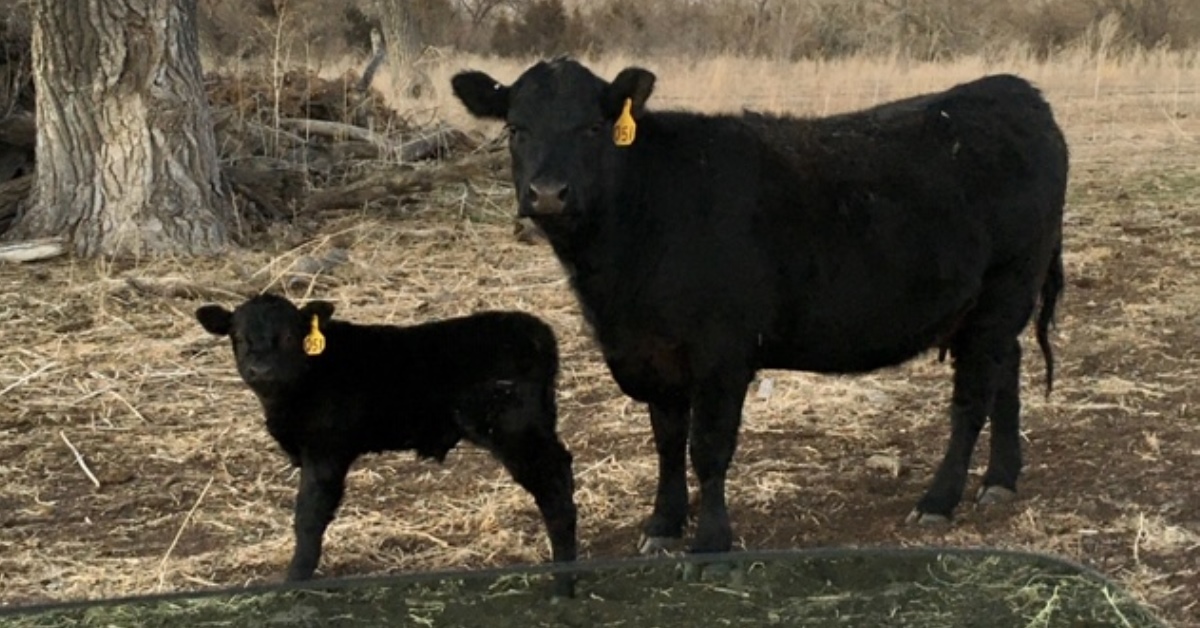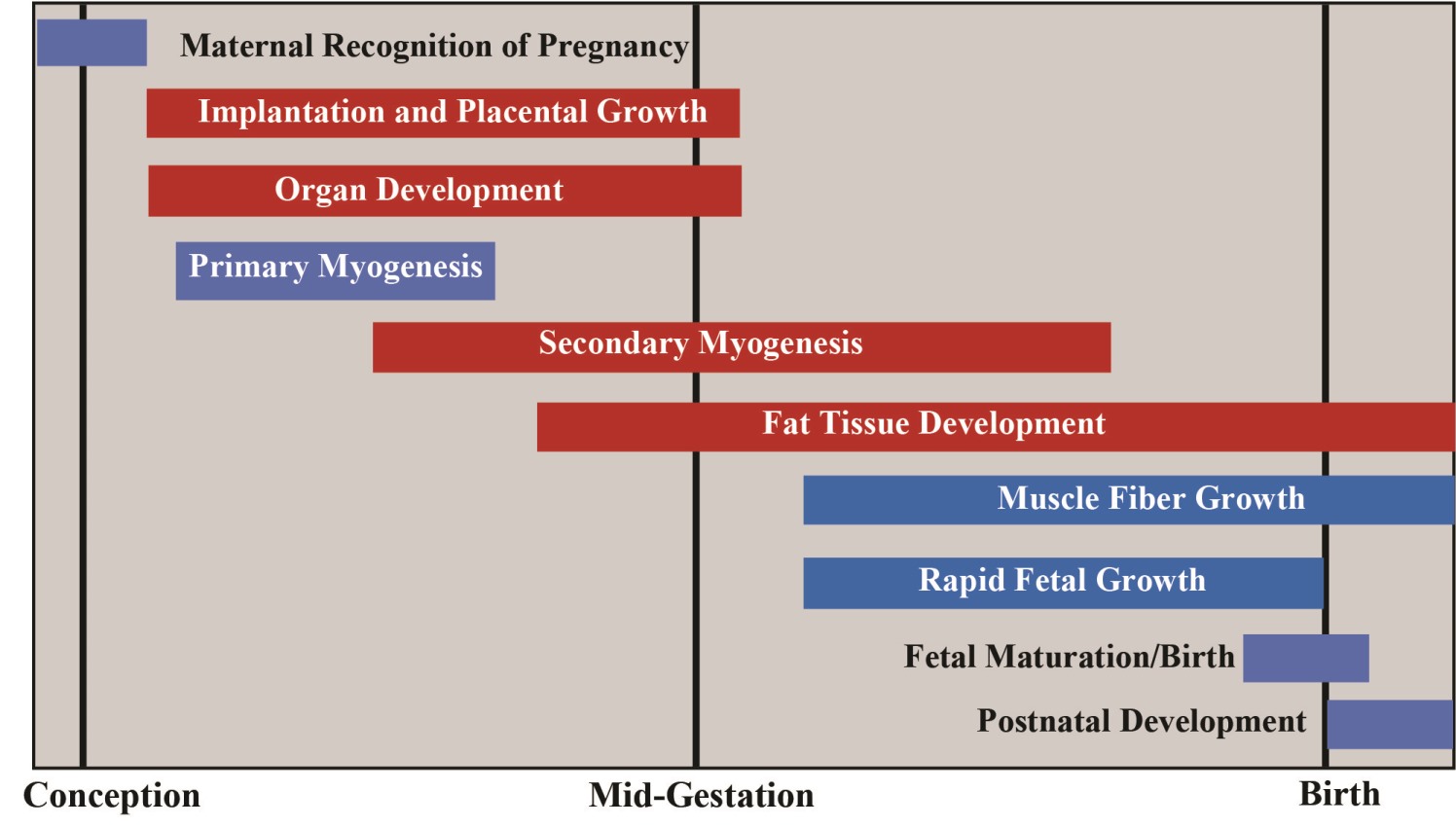
By: Cadra Van Bibber-Krueger, Ph.D., Beef Nutritionist, Hubbard Feeds
It’s that time of year again when calves are being weaned and forages are changing from green, nutrient-dense grass to a brown, less digestible feedstuff. Through all the hustle and bustle of weaning calves and the upcoming harvest, it is important not to neglect the second-trimester cow. Her nutrition program during this time will set the course for her winter feed needs as well as the future performance of her developing fetus.
Fetal development
Although the pregnant cow’s energy requirements during the second trimester are declining due to decreased lactation, the requirements needed to maintain and grow a healthy fetus are still increasing. During the first two trimesters, the fetus is growing at a relatively slow pace, but there are many events occurring that can alter the ability of the offspring to perform to its greatest potential.
During the first 150 days of gestation, placental development and attachment occur in unison with fetal organ development. This is also the time for the development of both primary and secondary muscle fibers (primary and secondary myogenesis). The process of developing muscle fibers is particularly important in offspring destined for the feedlot. Muscle fibers present at birth will increase in size, but not in number. This highlights the importance of meeting the nutrient requirements of the gestating cow to maximize muscle fiber number while the calf is in utero. The illustration below summarizes critical windows for the growing fetus when external factors can alter development (adapted from Du et al., 2010, and Fowden et al., 2006).

In addition to muscle fiber development, adipose tissue begins to develop during the second trimester. Consequently, maternal nutrition can impact the amount of marbling the calf will acquire in the feedlot. During the final trimester, the rapid growth of the fetus coincides with increasing muscle fiber size and fetal maturation just prior to birth.
Impact of nutrient restriction during the second trimester
Organ development and placental growth are approaching completion during the second trimester, while at the same time muscle fiber development and the beginning of adipose tissue development are occurring. Fetal brain and organ development take precedence over muscle, bone and adipose tissue development, resulting in carcass tissues being more susceptible to nutrient restriction.
In a review written by Funston et al. (2010), steers from cows provided protein supplementation during gestation had heavier carcass weights and consumed more feed with no change in efficiency compared to steers from cows that had undergone periods of nutrient restriction. In addition, the period of mid-gestation was determined to be important for determining the tenderness of steaks as well as increasing intramuscular fat, leading to a more valuable carcass.
Vitamin and mineral restriction in utero can also lead to negative effects on calf development and metabolism. Overall, cattle entering the feedlot from nutrient-restricted mothers had decreased growth rate, suboptimal carcasses, an inability to metabolize nutrients efficiently and had poorer body composition when compared to calves from mothers who received adequate nutrition throughout gestation.
What to supplement and when
It is important to sample forages cattle will be eating through the fall and winter months to formulate an appropriate supplementation strategy. Hubbard Feeds offers a range of supplements to fit the individual producer’s needs. Spring-calving cattle grazing corn crop residue need to be supplemented protein, vitamins and minerals.
CRYSTALYX® brand low-moisture blocks offer a simple and effective means of delivering required nutrients. Cattle typically consume between 0.5 to 1.1 pounds per head per day of these self-fed protein supplements. The blocks should be placed in areas to achieve the desired intake levels with one container for every 20–30 head. Free choice salt should be offered along with CRYSTALYX® brand low-moisture blocks.
Spring-calving cattle maintained on dormant grass pastures and/or fed hay can be supplemented with Rangeland Cake. Protein concentrations range from 12 to 20 percent. Rangeland Cake is typically fed at 2 to 4 pounds daily. When feeding Rangeland Cake, include STOCKMASTER® mineral or CRYSTALYX® Breed Up® Max, Crystal-Phos® or Mineral-Lyx® low-moisture blocks to meet vitamin and mineral requirements. To address deficiencies and antagonists, consider a product fortified with organic trace minerals.
Decreased growth rate and suboptimal carcasses cost feedlot producers millions of dollars annually (Caton and Hess, 2010). Providing adequate nutrition to the often neglected second-trimester cow can help to alleviate some of those monetary losses by developing calves that have been programmed to perform optimally.
References
Du et al. 2010. Fetal Programming of Skeletal Muscle Development in Ruminants. J. Anim. Sci. 88: E51-E60.
Fowden et al. 2006. Intrauterine Programming of Physiological Systems: Causes and Consequences. Physiol. 21:29-37.
Funston et al. 2010. Effects of Maternal Nutrition on Conceptus Growth and Offspring Performance: Implications for Beef Cattle Production. J. Anim. Sci. 88(E. Suppl.): E205-E215.
Caton and Hess. 2010. Maternal Plane of Nutrition: Impacts on Fetal Outcomes and Postnatal Offspring Responses. Proceedings of the 4th Grazing Livestock Nutrition Conference. pg. 104-122.
- Log in to post comments
